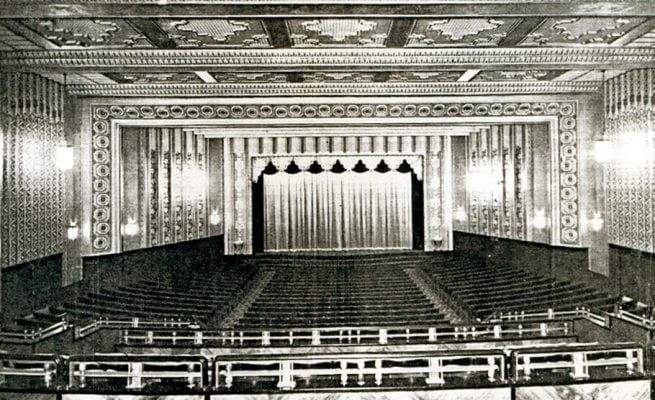The cinema is dead! Long live to cinema!
 Discuss the end of cinema dates back to the last century, notably when television began to expand and become ubiquitous in many homes. In Brazil, however, this discussion only began in the early 1980s, when TV broadcasts got nationwide coverage, and people preferred to stay at home in front of the television.
Discuss the end of cinema dates back to the last century, notably when television began to expand and become ubiquitous in many homes. In Brazil, however, this discussion only began in the early 1980s, when TV broadcasts got nationwide coverage, and people preferred to stay at home in front of the television.
It is quite true that, at that time, neither the image quality nor the TV schedule of the broadcasters were able to confront the exceptional photography of cinema, displayed on a huge screen, even in the smallest cities of the country. The attractions were, besides the lazyness, the soap operas and programs of auditorium, and progressively, color screens.

The city of my childhood and adolescence, Santa Rita, now an extension of the Paraíba capital, had three theaters running simultaneously, with a daily session and an additional matinese on weekends. With cheap tickets and a great variety of titles, the Seventh Art was worthy of its slogan, “Cinema is the best fun.”
The pace of the world was different, there was the Cold War, military dictatorship, media censorship, and the movies, in addition to being slow to arrive, circulated unhurriedly throughout the country. Thus, a major world premiere would take a few months to reach Rio and Sao Paulo, passing to other capitals and cities, larger and smaller, obeying a hierarchical order of size and wealth.
 The 1980s in Brazil were assaulted by diversification on open TV, political openness, end to censorship, and an alien element, the VCR. The market received new broadcasters such as Manchete, for example, who has reinvigorated the offer of journalism and movie, once a « global » privilege. Suddenly, from repeated 1950s and 1960s black-and-white films, we started watching fresh, two- or three-year-old movies!
The 1980s in Brazil were assaulted by diversification on open TV, political openness, end to censorship, and an alien element, the VCR. The market received new broadcasters such as Manchete, for example, who has reinvigorated the offer of journalism and movie, once a « global » privilege. Suddenly, from repeated 1950s and 1960s black-and-white films, we started watching fresh, two- or three-year-old movies!
The VCR, which at that time could only be “imported-smuggled”, was a precious item, but it gave movie buffs the chance to watch a film with a higher quality than most broadcasters, whenever they wanted, without leaving home! I remember our Friday family program was to the video store to rent the weekend movies, with options ranging from kids animations to dramas, including even erotic films every once in a while.
 Traditional cinema, in turn, failed to react with the necessary dynamics. Encased in their traditional form, they refused to change anything, either innovations or adaptations to a world that was changing at a great speed. I remember complaining about a faulty speaker at a local movie theater, and six months later I found that the problem was still exactly the same.
Traditional cinema, in turn, failed to react with the necessary dynamics. Encased in their traditional form, they refused to change anything, either innovations or adaptations to a world that was changing at a great speed. I remember complaining about a faulty speaker at a local movie theater, and six months later I found that the problem was still exactly the same.
Meanwhile, the supply for home cinema was improving every day. Larger TVs were offered at competitive prices, and soon came the stereo VCRs, which could even be plugged into a traditional stereo system. For the most demanding, however, paradise has come with home theaters, DVD players and flat-screen TVs.
 Most traditional movie theaters closed their doors, being transformed in parking lots, shops or evangelical temples. The survival of the rooms happened through multiplex theaters, always in shopping malls, but now radically changing its consumer audience. By location, ticket and snack prices, today’s theaters are aimed to the middle class, very different from the mass entertainment aspect they once had.
Most traditional movie theaters closed their doors, being transformed in parking lots, shops or evangelical temples. The survival of the rooms happened through multiplex theaters, always in shopping malls, but now radically changing its consumer audience. By location, ticket and snack prices, today’s theaters are aimed to the middle class, very different from the mass entertainment aspect they once had.
With the advent of the Internet at ever-increasing speeds and data volumes, new forms of consumption have been made available to the public. For a while, video stores provided home entertainment side by side with pirated DVDs, but new opponents, movie downloads and streaming services soon arrived.
 Downloading movies over the Internet is commonly referred to as “illegal downloading”. I have my caveats about this, but the topic would deserve an article in itself. The truth is that the internet has become a big store in the cloud, especially for movies and series that have never been released on video or DVD (and many will never be on Netflix).
Downloading movies over the Internet is commonly referred to as “illegal downloading”. I have my caveats about this, but the topic would deserve an article in itself. The truth is that the internet has become a big store in the cloud, especially for movies and series that have never been released on video or DVD (and many will never be on Netflix).
But, the beloved child of current video market is the streaming service. Started by Netflix, today the market is disputed by several competitors, some legal and some not so much, but it is undeniable that it is a path without return. The advantages are countless: no one needs to store physical media, the catalog is huge, and numerous platforms can be used, such as computers, tablets, mobile phones, smart TVs and any device that can access the internet.
 Interestingly, the disadvantages are linked to the same aspects. Since there is no physical media, there is no way to store that favorite movie. The catalog is large, but does not include all the classics, and any title can be removed without warning. Regardless of which platform you use, they all depend entirely on the internet to function.
Interestingly, the disadvantages are linked to the same aspects. Since there is no physical media, there is no way to store that favorite movie. The catalog is large, but does not include all the classics, and any title can be removed without warning. Regardless of which platform you use, they all depend entirely on the internet to function.
The patient reader who has come to this point must be wondering if I am pessimistic about the future of cinema. Well, to level the knowledge, I believe that cinema exists regardless of the format or where it is being displayed. For example, for me Super8 movie, VHS tape, DVD, Blu-ray, avi or mkv file, any form of storage is worth it.
 The same is for capture or display. Was it filmed with a VHS camera, a mobile phone or a 3D camera? Is it a 16mm projector projecting a silent film on a sheet hanging on the wall, watching on the mobile screen or the most modern cinema in the world? In my humble vision, if it has a history and is a moving image, it is cinema.
The same is for capture or display. Was it filmed with a VHS camera, a mobile phone or a 3D camera? Is it a 16mm projector projecting a silent film on a sheet hanging on the wall, watching on the mobile screen or the most modern cinema in the world? In my humble vision, if it has a history and is a moving image, it is cinema.
I am proud to have witnessed the fantastic evolution of cinema in recent decades, with increasingly sophisticated audio and video capabilities exploited in both traditional theaters and home appliances, computers and cell phones. Multichannel sound, ever-increasing graphic resolution, LED, OLED, QLED displays, data transmission at breakneck speeds, WiFi, Bluetooth, etc … In fact, convergence is the watchword.
 And if you think about everything I’ve said so far, what we have witnessed is a great resilience of the Seventh Art, an immense capacity for adaptation and survival, and the certainty that our descendants will still enjoy this pleasure in the times to come. . Will it be with a holographic television or direct brain broadcast? I don’t know, and it doesn’t matter, cinema is cinema.
And if you think about everything I’ve said so far, what we have witnessed is a great resilience of the Seventh Art, an immense capacity for adaptation and survival, and the certainty that our descendants will still enjoy this pleasure in the times to come. . Will it be with a holographic television or direct brain broadcast? I don’t know, and it doesn’t matter, cinema is cinema.






